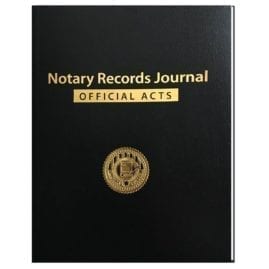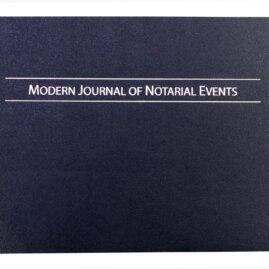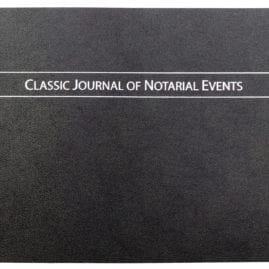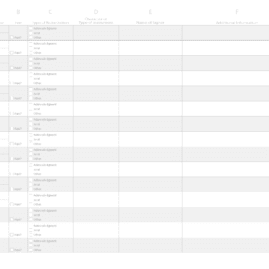Montana Notary Journals
Does Montana require a notary journal?
Yes. Montana requires a notary journal. Source: https://sosmt.gov/notary/journal.
- The date and time of the notarization.
- The type of notarial act. Only seven possibilities exist: taking an acknowledgment (“Acknowledgement”); administering an oath/affirmation (“Oath”); taking a verification on oath/affirmation (“Jurat”); witnessing/attesting a signature (“Signature”); certifying/attesting a copy (“Certification of Copy”); certifying/attesting a transcript of an affidavit or deposition (“Deposition”) and noting a protest of a negotiable instrument (“Protest Instrument”).
- A description of the document. Typically, this is the date of the document and the type of document such as “contract,” “deed,” “power of attorney,” “affidavit,” etc. If more than one document is being notarized, each document should be described.
- The type of identification used. If identification is based on personal knowledge, an entry of “P.K.” is acceptable. If identification is based on satisfactory evidence, a brief description of the method of identification used (credible witness or ID document) should be noted, as well as the date of issuance or expiration of any ID document used.
- The signature, printed name, and address of the person for whom the notarial act was performed. This information should be entered by the person who is requesting the notarization. Exception: Certifying transcripts of depositions and certifying copies do not require the signature of the individual for whom the notarial act is performed.
- The fee (if any) charged for the notarization.
-
Alabama, Alabama Notary Journals, Alaska, Alaska Notary Journals, Arizona, Arizona Notary Journals, Arkansas, Arkansas Notary Journals, California, California Notary Journals, Colorado, Colorado Notary Journals, Connecticut, Connecticut Notary Journals, Delaware, Delaware Notary Journals, District of Columbia, Florida, Florida Notary Journals, Georgia, Georgia Notary Journals, Hawaii, Hawaii Notary Journals, Idaho, Idaho Notary Journals, Illinois, Illinois Notary Journals, Indiana, Indiana Notary Journals, Iowa, Iowa Notary Journals, Kansas, Kansas Notary Journals, Kentucky, Kentucky Notary Journals, Louisiana, Louisiana Notary Journals, LTBB, Maine, Maine Notary Journals, Maryland, Maryland Notary Journals, Massachusetts, Massachusetts Notary Journals, Michigan, Michigan Notary Journals, Minnesota, Minnesota Notary Journals, Mississippi, Mississippi Notary Journals, Missouri, Missouri Notary Journals, Montana, Montana Notary Journals, Nebraska, Nebraska Notary Journals, Nevada, Nevada Notary Journals, New Hampshire, New Hampshire Notary Journals, New Jersey, New Jersey Notary Journals, New Mexico, New Mexico Notary Journals, New York, New York Notary Journals, North Carolina, North Carolina Notary Journals, North Dakota, North Dakota Notary Journals, Notary Journals, Ohio, Ohio Notary Journals, Oklahoma, Oklahoma Notary Journals, Oregon, Oregon Notary Journals, Pennsylvania, Pennsylvania Notary Journals, Rhode Island, Rhode Island Notary Journals, South Carolina, South Carolina Notary Journals, South Dakota, South Dakota Notary Journals, Tennessee, Tennessee Notary Journals, Texas, Texas Notary Journals, Utah, Utah Notary Journals, Vermont, Vermont Notary Journals, Virginia, Virginia Notary Journals, Washington, Washington D.C., Washington Notary Journals, West Virginia, West Virginia Notary Journals, Wisconsin, Wisconsin Notary Journals, Wyoming, Wyoming Notary Journals
Notary Records Journal
$22.95 – $28.95Notary Records Journal Features:
128 heavy weight pages
496 individually numbered entries (1-496)
Durable, high-quality construction
4 entries per page
Entries contained to one page (no page-spanning entries)
Convenient check boxes to speed up entries
Detailed areas…Select options This product has multiple variants. The options may be chosen on the product pageQuick View -
Alabama, Alabama Notary Journals, Alaska, Alaska Notary Journals, Arizona, Arizona Notary Journals, Arkansas, Arkansas Notary Journals, California, California Notary Journals, Colorado, Colorado Notary Journals, Connecticut, Connecticut Notary Journals, Delaware, Delaware Notary Journals, District of Columbia, Florida, Florida Notary Journals, Georgia, Georgia Notary Journals, Hawaii, Hawaii Notary Journals, Idaho, Idaho Notary Journals, Illinois, Illinois Notary Journals, Indiana, Indiana Notary Journals, Iowa, Iowa Notary Journals, Kansas, Kansas Notary Journals, Kentucky, Kentucky Notary Journals, Louisiana, Louisiana Notary Journals, LTBB, Maine, Maine Notary Journals, Maryland, Maryland Notary Journals, Massachusetts, Massachusetts Notary Journals, Michigan, Michigan Notary Journals, Minnesota, Minnesota Notary Journals, Mississippi, Mississippi Notary Journals, Missouri, Missouri Notary Journals, Montana, Montana Notary Journals, Nebraska, Nebraska Notary Journals, Nevada, Nevada Notary Journals, New Hampshire, New Hampshire Notary Journals, New Jersey, New Jersey Notary Journals, New Mexico, New Mexico Notary Journals, New York, New York Notary Journals, North Carolina, North Carolina Notary Journals, North Dakota, North Dakota Notary Journals, Notary Journals, Ohio, Ohio Notary Journals, Oklahoma, Oklahoma Notary Journals, Oregon, Oregon Notary Journals, Pennsylvania, Pennsylvania Notary Journals, Rhode Island, Rhode Island Notary Journals, South Carolina, South Carolina Notary Journals, South Dakota, South Dakota Notary Journals, Tennessee, Tennessee Notary Journals, Texas, Texas Notary Journals, Utah, Utah Notary Journals, Vermont, Vermont Notary Journals, Virginia, Washington, Washington D.C., Washington Notary Journals, West Virginia, West Virginia Notary Journals, Wisconsin, Wisconsin Notary Journals, Wyoming, Wyoming Notary Journals
Modern Journal of Notarial Events
$22.95 – $28.95We designed our Modern Notary journal to serve the professional Notary public. The ideal journal for Notary signing agents, our Modern Notary journal focuses on loan signings and common Notarial…
Select options This product has multiple variants. The options may be chosen on the product pageQuick View -
Alabama, Alabama Notary Journals, Alaska, Alaska Notary Journals, Arizona, Arizona Notary Journals, Arkansas, Arkansas Notary Journals, California, California Notary Journals, Colorado, Colorado Notary Journals, Connecticut, Connecticut Notary Journals, Delaware, Delaware Notary Journals, District of Columbia, Florida, Florida Notary Journals, Georgia, Georgia Notary Journals, Hawaii, Hawaii Notary Journals, Idaho, Idaho Notary Journals, Illinois, Illinois Notary Journals, Indiana, Indiana Notary Journals, Iowa, Iowa Notary Journals, Kansas, Kansas Notary Journals, Kentucky, Kentucky Notary Journals, Louisiana, Louisiana Notary Journals, LTBB, Maine, Maine Notary Journals, Maryland, Maryland Notary Journals, Massachusetts, Massachusetts Notary Journals, Michigan, Michigan Notary Journals, Minnesota, Minnesota Notary Journals, Mississippi, Mississippi Notary Journals, Missouri, Missouri Notary Journals, Montana, Montana Notary Journals, Nebraska, Nebraska Notary Journals, Nevada, Nevada Notary Journals, New Hampshire, New Hampshire Notary Journals, New Jersey, New Jersey Notary Journals, New Mexico, New Mexico Notary Journals, New York, New York Notary Journals, North Carolina, North Carolina Notary Journals, North Dakota, North Dakota Notary Journals, Notary Journals, Ohio, Ohio Notary Journals, Oklahoma, Oklahoma Notary Journals, Oregon, Oregon Notary Journals, Pennsylvania, Pennsylvania Notary Journals, Rhode Island, Rhode Island Notary Journals, South Carolina, South Carolina Notary Journals, South Dakota, South Dakota Notary Journals, Tennessee, Tennessee Notary Journals, Texas, Texas Notary Journals, Utah, Utah Notary Journals, Vermont, Vermont Notary Journals, Virginia, Virginia Notary Journals, Washington, Washington D.C., Washington Notary Journals, West Virginia, West Virginia Notary Journals, Wisconsin, Wisconsin Notary Journals, Wyoming, Wyoming Notary Journals
Classic Journal of Notarial Events
$22.95 – $28.95Classic Notary Journal
Our Classic Journal of Notarial Events is the journal for workplace notaries. Incredibly durable construction, with 128 heavyweight pages, and room for 15 entries per page. Traditional “Ledger” format.
Select options This product has multiple variants. The options may be chosen on the product pageQuick View








